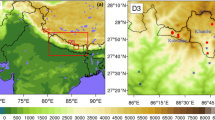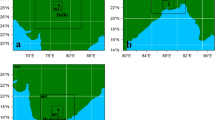Abstract
The urban convective atmospheric boundary layer (ABL) structure and its evolution were studied with Weather Research and Forecasting (WRF) model for the period of Sofia Experiment 2003. The experimental data of 2003 used for model validation encompass turbulent fluxes and profiles of temperature, humidity, wind speed and direction. Configuration using two datasets for topography (SRTM, NASA) and land cover (CORINE 2012) was implemented in WRF model. The spatial distribution of modelled maximal values of sensible and latent heat fluxes clearly indicated the location of big green areas in Sofia city, water bodies and mountain ridges. The model was able to reproduce sensible heat flux adequately for the entire period of the experiment with exception of September 30th when 2.6 mm rain was recorded. The model was able to capture the sharp jump in the latent heat flux after the rainfall, but with two hours delay. The model maximal values of friction velocity were overestimated compared to the measured ones.
Access provided by Autonomous University of Puebla. Download conference paper PDF
Similar content being viewed by others
1 Sofia Experiment 2003
Up-to-date mesoscale meteorological models have parameterization and dynamic options that allow description of different scales of atmospheric processes from meters to thousands of kilometres. An observation data set with high spatial and temporal resolution is necessary for model validation to be able to find the best model configuration. Such data set was collected during the experimental campaign (Batchvarova & Rotach, 2005; Batchvarova et al., 2007) conducted in Sofia from September 27nd to October 3rd, 2003. The experiment program has contained measurements of turbulent fluxes and aerological observations tracking the development of the convective ABL in urban environment. Acoustic anemometers and fast hydrometer were mounted on the research tower at NIMH-BAS at height of 20 and 40 m above the ground and they were set with 30-min averaging time. The sondes were launched every 2 h (from 04 to 16 GMT).
2 WRF Model Setup
Numerical simulations are performed with the Advanced Research WRF (ARW) Version 3.8. (http://www.mmm.ucar.edu/wrf/users/docs) initialized with 0.25 degree NCEP Final Operational Analyses every 6 h. Four nested domains are used based on a Lambert Projection, centred at 42.68 N and 23.36 E with resolution of 32 km (D1), 8 km (D2), 2 km (D3) and 500 m (D4). Two new datasets for topography (SRTM, NASA) and land cover (CORINE 2012) were implemented in WRF. Four dimensional data assimilation (FDDA) is used for domain D1 at all vertical levels, and for domains D2, D3 only above the first 10 model levels. The FDDA option is not applied for D4. The parametrization of physical processes used in this study is listed in Table 1. Vertical structure of the atmosphere is presented through 50 levels going up to 50 hPa. A 48-h simulation period is performed for each day of the experiment, considering 24 h spin-up period.
3 Model Results Validation
The model performance is estimated using standard statistic measures - mean values, mean bias (MB, model-observation), normalized root mean square error (NRMSE), standard deviation (SD), mean absolute error (MAE) and Pearson correlation coefficient (r). Observations for the potential temperature (Θ), relative humidity (RH), mixing ratio (MR) and wind speed (WS) are interpolated to the model levels. Comparison between simulated and observed parameters for all hours up to 8000 m (Table 2) shows a positive very strong correlation. All parameters are slightly underestimated by the model, except potential temperature.
The transition from stable to convective boundary layer in the morning hours is clearly displayed in both observed and modelled Θ profiles. Both profiles at 04 GMT (Fig. 1) show a stable layer approximately 250 m, residual convective layer between 1000 and 1800 m, and vast entrainment zone between them. The convective layer (CL) starts to grow at 8 GMT. The simulated Θ is 2 K lower than observed at the ground at this time. The model results are in agreement with observations for the height of CL. It is approximately 750 m at 10 GMT, 1750 m at 12 GMT and 2000 m at 14 GMT. The model Θ values are lower close to the ground during the day, but the biases reduce with the CL development.
Turbulent characteristics—sensible heat flux (HFX), latent heat flux (LH) and friction velocity (U*) are also validated. Figure 2 shows that the model adequately describes the HFX except for September 30th after the rainfall, when the model overestimates about 2 times observations. WRF describes the sharp jump in LH value after the rain on September 30th, but with about 2 h delay. The simulated maximal values of U* are overestimated by the model (with exception on September 29th), while WRF generally underestimates nocturnal U* values, except night on September 26th.
The spatial distribution of modeled maximal HFX and LH (Fig. 3) clearly indicates that the model describes correctly city parks with lower values of HFX and higher for LH. High values of LH are calculated for the water basins around the city and low for the built-up areas. High HFX values are calculated in the city and on the ridges of the surrounding mountains.
4 Conclusions
The results of validation of WRF over Sofia urban area located in complex terrain show that the model adequately describes vertical profiles and turbulent fluxes with the selected parametrization of physical processes.
References
Batchvarova, E., & Rotach, M. W. (2005). Bilateral co-operation on urban boundary layer studies. Turbulence measurements for urban boundary layer research in Sofia (pp. 185–188). Final report COST action 715, ISBN: 978-954-9526-30-1.
Batchvarova, E., Gryning, S.-E., Rotach, M. W., & Christen, A. (2007). Comparison of modeled aggregated turbulent fluxes and measured turbulent fluxes at different heights in an urban area. In C. Borrego & A. Norman (Eds.), Air Pollution Modeling and its Application XVII (pp. 363–370). Kluwer Academic/Plenum Publishers.
Acknowledgements
This research is supported by the project DN4/7 (Study of the PBL structure and dynamics over complex terrain and urban area), funded by the National Science Fund of the Bulgarian Ministry of Education and Science.
Author information
Authors and Affiliations
Corresponding author
Editor information
Editors and Affiliations
Rights and permissions
Copyright information
© 2021 The Author(s), under exclusive license to Springer-Verlag GmbH, DE, part of Springer Nature
About this paper
Cite this paper
Kirova, H., Batchvarova, E., Dimitrova, R., Vladimirov, E. (2021). Validation of WRF with Detailed Topography Over Urban Area in Complex Terrain. In: Mensink, C., Matthias, V. (eds) Air Pollution Modeling and its Application XXVII. ITM 2019. Springer Proceedings in Complexity. Springer, Berlin, Heidelberg. https://doi.org/10.1007/978-3-662-63760-9_51
Download citation
DOI: https://doi.org/10.1007/978-3-662-63760-9_51
Published:
Publisher Name: Springer, Berlin, Heidelberg
Print ISBN: 978-3-662-63759-3
Online ISBN: 978-3-662-63760-9
eBook Packages: Physics and AstronomyPhysics and Astronomy (R0)







